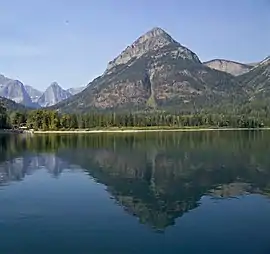Olson Mountain
Olson Mountain,[3] also known as Mount Olson, is a 7,913 feet (2,412 m) mountain summit located in the Livingston Range, of Glacier National Park in the U.S. state of Montana. Olson Mountain rises more than 3,700 feet (1,100 m) above the western shore of Waterton Lake. The mountain was named for a surveyor on the International Boundary Survey, with the name officially adopted in 1929.[3] The nearest higher peak is Campbell Mountain, 1.13 miles (1.82 km) to the north.[1] Precipitation runoff from the mountain drains into Olson Creek before it empties to Waterton Lake.
| Olson Mountain | |
|---|---|
 Olson Mountain reflected in Waterton Lake | |
| Highest point | |
| Elevation | 7,913 ft (2,412 m) [1] |
| Prominence | 793 ft (242 m) [1] |
| Coordinates | 48°57′26″N 113°56′15″W [2] |
| Geography | |
 Olson Mountain Location in Montana  Olson Mountain Location in the United States | |
| Location | Glacier County, Montana, U.S. |
| Parent range | Livingston Range |
| Topo map | USGS Porcupine Ridge, MT |

Climate
Based on the Köppen climate classification, Olson Mountain is located in a subarctic climate zone characterized by long, usually very cold winters, and short, cool to mild summers.[4] Temperatures can drop below −10° F with wind chill factors below −30° F.
Geology
Like other mountains in Glacier National Park, Olson Mountain is composed of sedimentary rock laid down during the Precambrian to Jurassic periods. Formed in shallow seas, this sedimentary rock was initially uplifted beginning 170 million years ago when the Lewis Overthrust fault pushed an enormous slab of precambrian rocks 3 mi (4.8 km) thick, 50 miles (80 km) wide and 160 miles (260 km) long over younger rock of the cretaceous period.[5]
See also
References
- "Olson Mountain, Montana". Peakbagger.com. Retrieved 2019-01-17.
- https://listsofjohn.com/peak/26696
- "Olson Mountain". Geographic Names Information System. United States Geological Survey. Retrieved 2019-01-17.
- Peel, M. C.; Finlayson, B. L.; McMahon, T. A. (2007). "Updated world map of the Köppen−Geiger climate classification". Hydrol. Earth Syst. Sci. 11: 1633–1644. ISSN 1027-5606.
- Gadd, Ben (2008). "Geology of the Rocky Mountains and Columbias". Cite journal requires
|journal=(help)
External links
- Weather forecast: Olson Mountain
- National Park Service web site: Glacier National Park